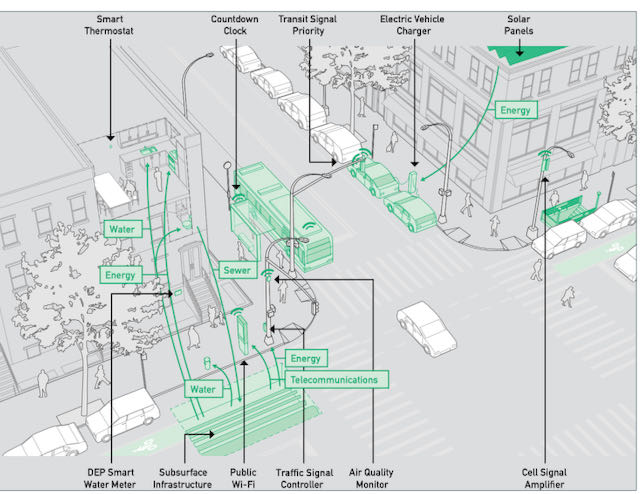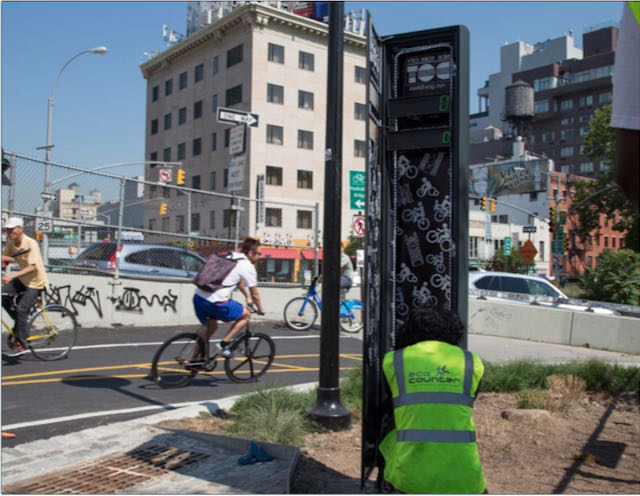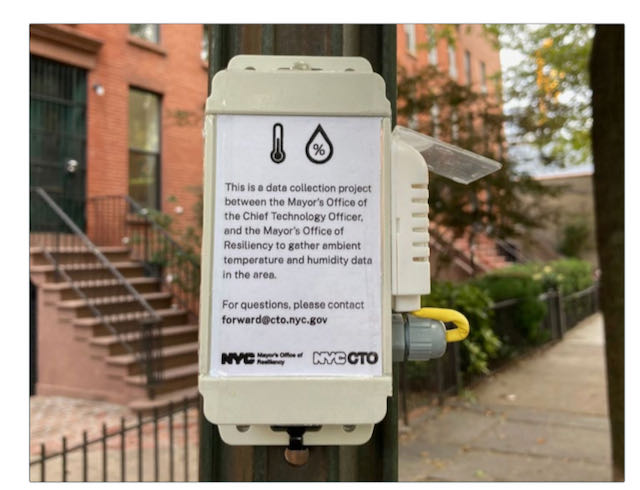
Cities such as New York City are highly crowded areas with a complex web of urban (or in some locations rural) operating systems. Any smart city development efforts have to be balanced against the challenges of private utilities; legacy infrastructures; KPI-dependent local, state, and federal governments; ROI; and public views. City planners have to consider not only the needs of current residents but those in decades to come, taking into account shifts in migration, weather changes due to climate change, and the potential of future pandemics like COVID-19. They also need to anticipate the deployment of future technologies (such as drones, hyperloop transport, and autonomous vehicles) before their rollout.

“connected city” first appeared in
OneNYC 2050 and was reproduced in the NYC IoT Strategy
The Mayor’s Office of the Chief Technology Officer recently released the NYC Internet of Things Strategy to support a healthy cross-sector IoT ecosystem in New York City. The 78-page NYC IoT Strategy contains a brief review of prior City work in this area, followed by a discussion of striking the right balance with IoT principles, such as privacy and transparency. The Strategy goes on to describe ways in which IoT presents both challenges and opportunities for the City. It concludes with a robust set of recommendations for a healthy IoT ecosystem and the way forward for smart city development.
The Strategy outlines five broad goals for near-term city action:
- Foster Innovation by creating structures and programs that support research, testing, and experimentation with IoT technologies.
- Promote Data Sharing and Transparency around City IoT use by engaging and informing residents about IoT initiatives and aggregating information and data from the City’s work to make them available across agencies and for the public, where appropriate.
- Improve Governance and Coordination of the City’s use of connected technologies through new policies and processes.
- Derive Value from Cross-Sector Partnerships by supporting and pursuing new opportunities for collaboration.
- Engage with Industry and Advocate for Communities by creating new channels for exchange and advocating for digital rights.
I spoke to Paul Rothman, Director of the Smart Cities + IoT Lab within the New York City Mayor’s Office of the CTO to find out more. He explained that part of his role is balancing multiple types of interactions, “convening and organizing within the City, helping to organize and spur collaboration within the City. As a mayoral office, we sometimes act as a convener or a link between different city agencies in different operations.”
Over the last decade, the New York City government has increased its use of connected devices to manage operations and infrastructure and provide services. Utilizing environmental sensors, GPS, utility meters, counters, cameras, and other connected devices has given cities more comprehensive data at an unprecedented scale. Cities are using this data to measure environmental conditions, set goals, and manage interventions that result in improvements for residents. They are tracking their fleets to optimize operations and implement preventive maintenance. Cities are monitoring the use of energy to increase efficiency. They are also analyzing the flow of people to better plan public space.
Flood monitoring
Paul notes that “academic partnerships are a way to expand the research and development capabilities in the City because we don’t necessarily have the engineers ourselves but instead can partner with academic institutions who do.” A great example of this in action is the City’s flood monitoring pilot.
The Mayor’s Office of Resiliency and NYC CTO partnered in April of 2020 with the City University of New York and New York University to co-develop a first-of-its-kind, real-time flood-monitoring system for parts of Brooklyn and Queens. The project is deploying Internet-connected sensors in flood-prone neighborhoods to measure the number of flooding incidents, as well as their depths. Sensors will rely on the LoRaWAN-based The Things Network for communication and may require new gateways to be installed where coverage isn’t already available.
As part of the pilot, the City will test the efficacy of the network and identify whether or not it can be a useful tool for future sensor deployments. The project will produce a software tool that will allow residents, NYC infrastructure and emergency management agencies and researchers to directly monitor the incoming data and receive alerts about weather events. This data will help inform residents, flood mitigation efforts, and calibrate future flooding models.
Data to drive city planning with privacy by design
Some of the most interesting use cases of IoT are the automation of previously manual, laborious tasks. According to Paul, “The Department of Transportation, for many years, has been collecting pedestrian data in a very analog way – what they refer to as bi-annual pedestrian counts where they send people to the street. They sit there with a clicker or capture video and literally count the people that they see.”

In 2021, the NYC DOT and NYC CTO will pilot computer vision technology to provide automated counts of pedestrians, cyclists, and vehicles as they move through parts of the City, with funding from the Empire State Development Corporation.
Having more rigorous data sets about how mobility habits and patterns are changing will enable DOT to better assess street design and road infrastructure to accommodate transportation evolution within the City. This year-long pilot is approached with “privacy by design” principles. The selected sensors will not transmit any image or video data from the device except during a brief calibration period. This approach allows the City to take advantage of the advanced classification and counting capabilities that come from vision but without the privacy concerns associated with video transmission and recording. During the course of the pilot, the City will engage with residents to gather input on the technology and will test a version of a privacy and equity impact assessment that could serve as a model for future smart city IoT projects.
Using IoT to aid smart city development and solve complex community challenges
Various community groups are using and engaging with IoT in New York City today.
The NYC[x] Co-Labs program is preparing to pilot an IoT project as part of a “Housing Rights Challenge” in Inwood and Washington Heights. NYC CTO, working with the Department of Housing Preservation and Development, NYCEDC, and the Mayor’s Office to Protect Tenants, will partner with Heat Seek, a New York City-based technology non-profit that creates low-cost, web-connected temperature sensors that help tenants prove and resolve illegal and sometimes life-threatening lack of heat in their apartments during cold winter months. Heat Seek installs proprietary temperature sensors and offers technical expertise to assist tenants in documenting landlord failures to provide adequate heat to restore that right through advocacy.
Consultation and citizen engagement is the way forward for smart city IoT
I’m always interested to know how cities qualify and measure the effectiveness of IoT pilots and projects, especially those yet to achieve ROI. Paul shares:
“We admittedly didn’t touch on the budgeting aspect all that much in the Strategy that we put out. I think we’re taking a tack, consisting of other kinds of innovation projects, that if we’re able to put a pilot in place that seems to generate enough value, it then becomes something that we can roll into the funding of an agency. We’re typically not looking to create solutions to problems that we don’t have time to look at or need to solve. It’s not tech for tech sake but rather we’re trying to understand where technology could improve resident experience or operations.”
Next steps for NYC IoT smart city development

The Strategy includes the priorities and next steps for the city’s smart city development. These include plans to:
- Update and maintain an internal inventory of City IoT devices on a continual basis.
- Establish a standardized device review process in coordination with agency stakeholders that includes equity, security, and privacy oversight.
- Establish scope and resources for citywide IoT data dashboard.
- Rapid IoT data collection program.
- Develop a municipal “testbed” and launch a continuous pilot program framework to utilize it, subject to City procurement rules.
- Launch a Smart City Catalog to publicly share information about City projects
The Strategy is not only a document that details how did we get here but where should we go next. According to Paul:
“One of the things that we’re doing right now is reaching out to different communities and stakeholders throughout the City. Now that we’ve been able to put the Strategy out there and are asking, “What are the things that resonate with you that you would be interested in being a part of, and what are the things that we missed? Are there things that we should be looking at that we’re not?” We’re going to do a follow-up within six months to pull together the information from these consultations. This will inform the work going forward as we set our proposed agenda and then use it as an opportunity to either course correct or balance our ways to approach things.“







